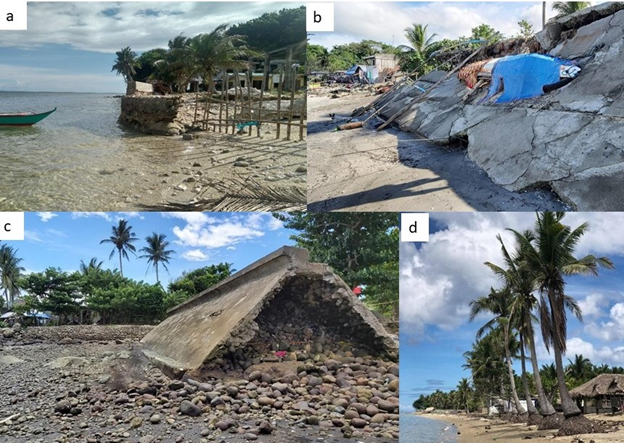The latest scientific reports released by the Marine Geological Survey Division of the Mines and Geosciences Bureau (MGSD-MGB) highlighted the physical vulnerability to coastal hazards of the seven municipalities (Sipocot, Lupi, Libmanan, Pasacao, Tinambac, Balanga, and Cabusao) in Camarines Sur and six municipalities (Gumaca, Lucena, Mauban, Sariaya, Padre Burgos and Real) in Quezon Province. By integrating data obtained from Camarines Norte earlier this year, the assessment results from Camarines Sur and Quezon provinces provided an overview of the present and future potential impacts of coastal erosion and other hazards (e.g., storm surge, tsunami) in southeastern Luzon.
MGSD reported that cumulative coastal erosion or shoreline retreat occurs in several coastal areas in Camarines Sur and Quezon provinces. This event is driven by relative sea-level rise related to climate change and enhanced by anthropogenic activities. Improperly sited ports and coastal engineering structures in a number of areas have been identified as among the factors that interfered with littoral sediment transport to cause coastal erosion. Unfortunately, some of these hard engineering defenses (e.g., seawall) provide a false sense of security against coastal erosion and other hazards, as communities at risk ended up expanding behind the structures following their construction. Human-induced disturbances have been observed like the accelerated sand loss in Camarines Norte and coastline recession in the provinces of Camarines Sur and Quezon. In addition, the destruction of natural barriers such as coral reefs and mangroves has increased the coastal hazards vulnerability of some communities in southeastern Luzon. Unlawful removal of coral reefs which help reduce wave impacts on the coast has been observed in a number of areas. Several mangrove forests have also been partially or completely removed through the years due to the expansion of communities and fishponds. Some mangroves have also been tapped as sources for coal on charcoal on the anecdotal accounts provided to the survey team. With these observations, coastal hazards in southeastern Luzon are clearly becoming a potential creeping crisis in southeastern Luzon.
Over the coming decades, the projected acceleration in sea level rise and greater frequency of strong typhoons in response to climate change is expected to increase the impacts of coastal erosion and storm surge in southeastern Luzon. A coordinated approach to identifying regional and local science-based coastal hazard management strategies and policies which affect coastal areas at all levels of governance is crucial to minimize exposure to coastal hazards.

Some photos of areas assessed for coastal hazards vulnerability in the provinces of Quezon and Camarines Sur. Coastal defense engineering structures seriously damaged by past storm surge events (Photos a-c): a- Barangay Lipata in Padre Burgos. Quezon; b- Barangay Sogod, Tinambac, Camarines Sur; c- Centro East, Barangay Anib, Camarines Sur. Coastal erosion at Barangay Pararao, Balatan, Camarines Sur (Photo d)
By: Marine Geological Survey Division
